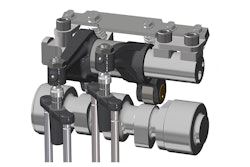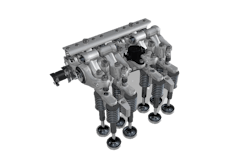
Jacobs Vehicle Systems’ High Power Density (HPD) engine brake has gone into production with a Chinese truck manufacturer. This is the first OEM application of HPD, launched in 2016, to be announced. The new Sinotruk Yellow River tractor unit, designed and manufactured by China National Heavy Duty Truck company (CNHTC), integrates Jacobs’ HPD technology in its 11- and 13-liter engines.
Yellow River is China’s most famous truck brand, dating back to the nation’s first ever heavy-duty truck, the Series JN150 of 1960. The latest-generation Yellow River tractor unit, primarily intended for long-haul applications, was launched with fanfare in mid-September at the Olympic Sports Center in Jinan, the capital of the Shandong province. This is the most technically-advanced vehicle to wear the Yellow River badge, and the latest step in CNHTC’s publicly-declared ambition to become a “world-class full-series commercial vehicle group.” The truck is distinguished by its aerodynamic body design and low unit drag coefficient to 0.37.
CNHTC’s 11- and 13-liter engines, designated MC11 and MC13 are modular designs, with six cylinders and turbocharging, and have B10-rated (1.1 million-mile) reliability. The MC11 produces 453 hp at 1,900 rpm and 2,200 Nm of torque at 1,000-1,400 rpm; the MC13 produces 532 hp at 1,800 rpm and 2,500 Nm at 1,000-1,400 rpm. The HPD 1.5 Stroke-equipped MC11 and MC13 engines are expected to be used in other applications.
Jacobs unveiled its HPD Engine Brake technology in 2016 in response to requests from global engine suppliers seeking high power density and a cost-effective alternative to the driveline retarder. HPD helps meet the need for stronger engine braking because fuel efficiency strategies have reduced the natural retarding effects of vehicle wind resistance and friction from engine, drivetrain and tires. HPD can deliver performance comparable to a driveline retarder, up to one-and-a-half times the braking performance of traditional compression release braking over the engine’s entire operating range, and more than two times the braking performance at lower rpm.
Jacobs modular HPD system allows OEMs to select different versions of the technology depending on the application. This includes full 2.0 Stroke, 1.5 Stroke, standard compression release (CR) and future protection for Cylinder Deactivation (CDA) and Late Intake Valve Closing (LIVC). HPD works by using cylinder deactivation mechanisms to eliminate different main event valve lift events so a second compression release event per cam rotation can be achieved.

















